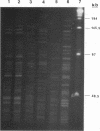Abstract
In 1991 and 1992, toxigenic Vibrio cholerae O1, serotype Inaba, biotype El Tor, was recovered from nonpotable (ballast, bilge, and sewage) water from five cargo ships docked in ports of the U.S. Gulf of Mexico. Four of these ships had taken on ballast water in cholera-infected countries; the fifth took on ballast in a noninfected country. Isolates examined by pulsed-field gel electrophoresis were indistinguishable from the Latin American epidemic strain, C6707; however, they differed significantly from the endemic Gulf Coast strain (VRL 1984), the sixth-pandemic strain (569-B), and a V. cholerae non-O1 strain isolated from a ship arriving from a foreign port. On the basis of our findings, the Food and Drug Administration recommended that the U.S. Coast Guard issue an advisory to shipping agents and captains requesting that ballast waters be exchanged on the high seas before entry of ships into U.S. ports.
Full text
PDF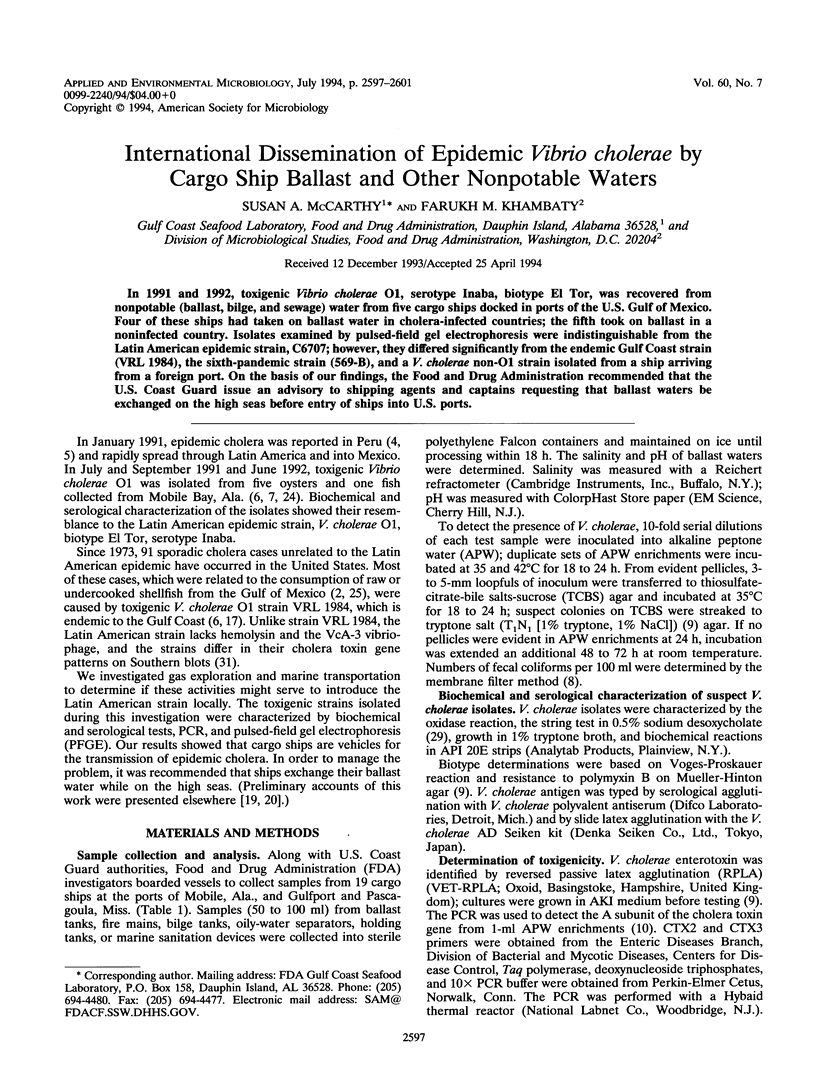
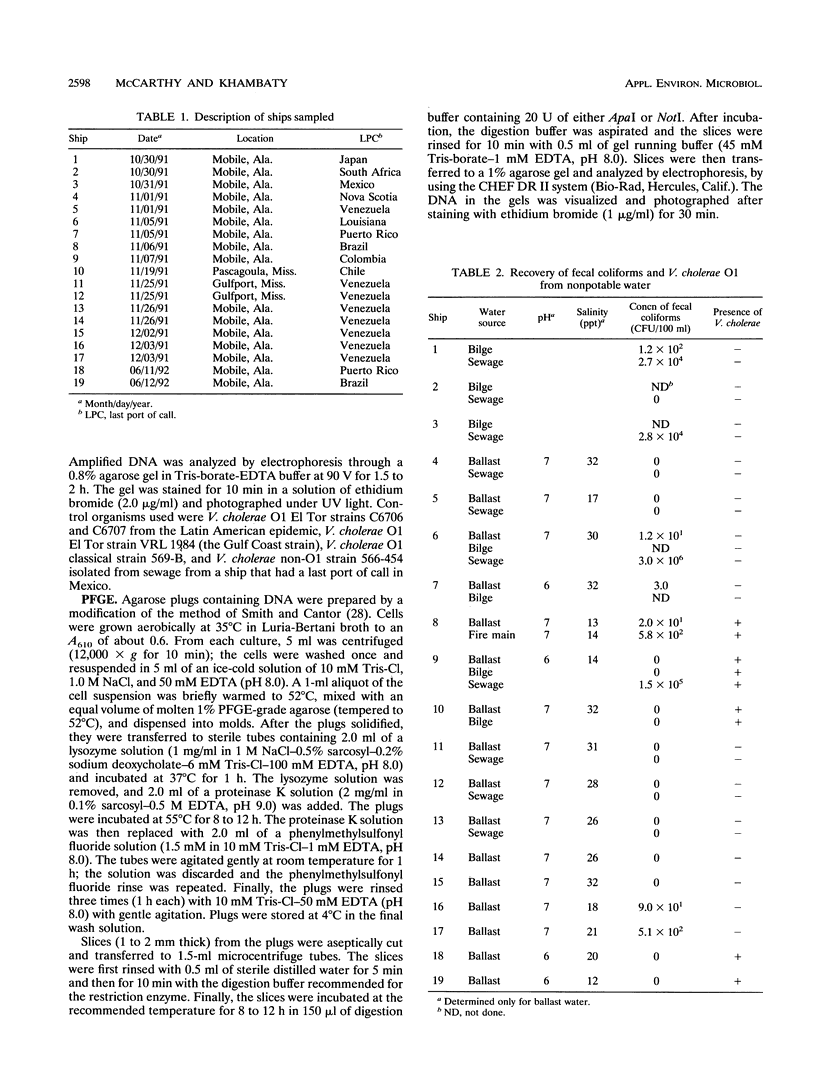
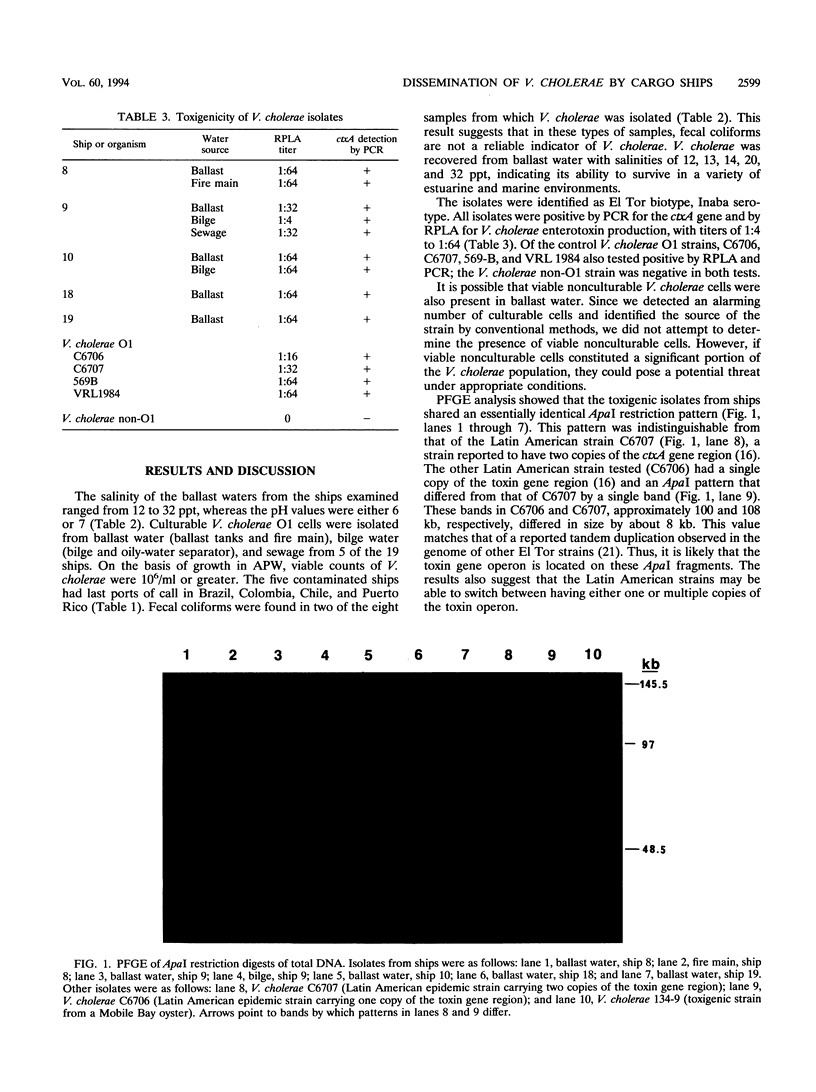
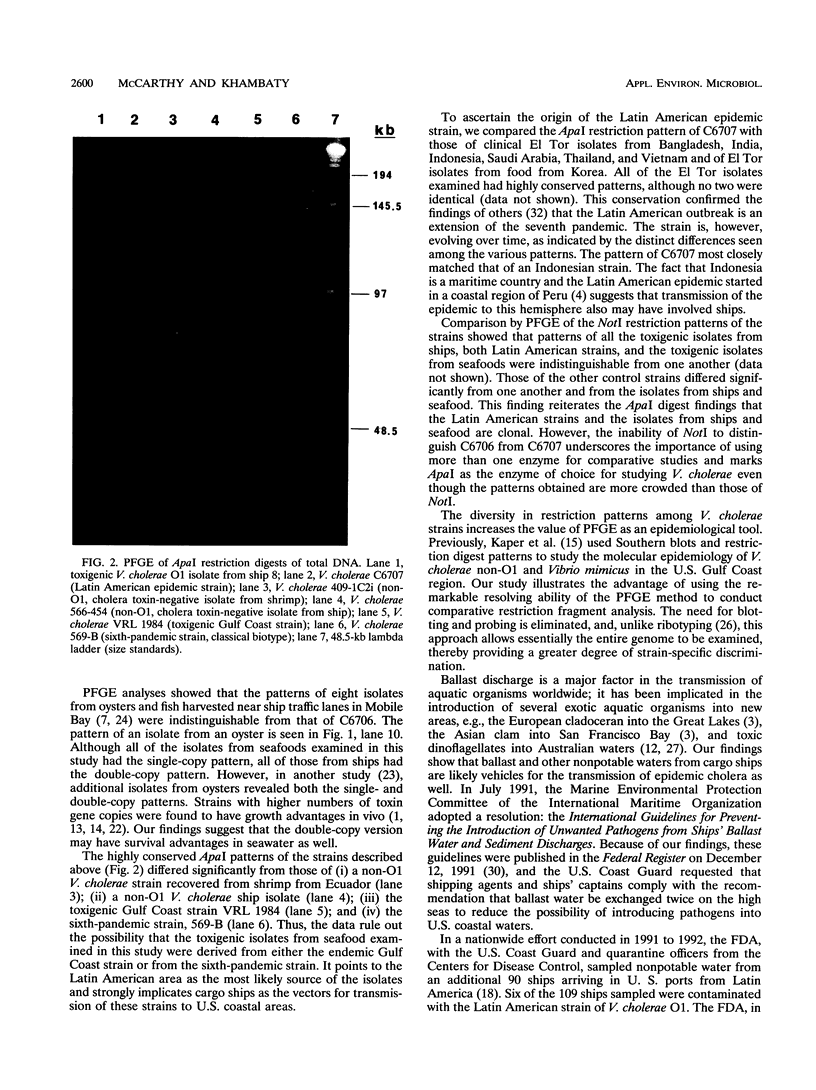
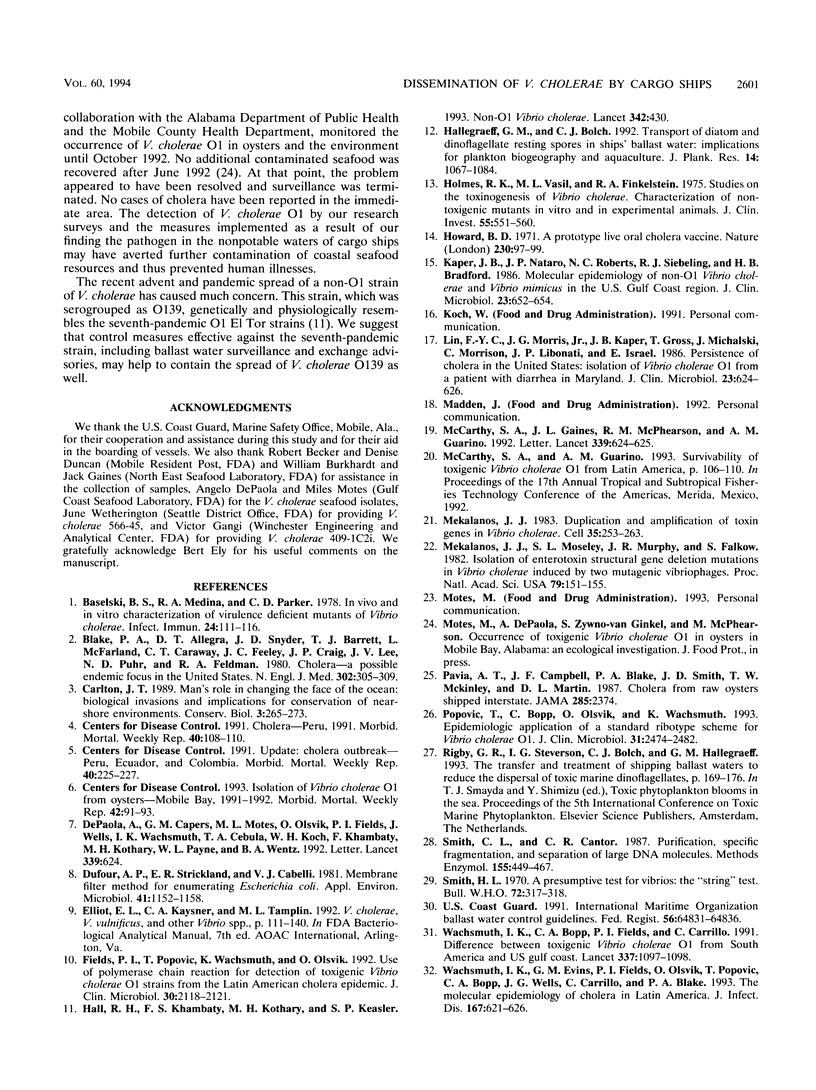
Images in this article
Selected References
These references are in PubMed. This may not be the complete list of references from this article.
- Baselski V. S., Medina R. A., Parker C. D. In vivo and in vitro characterization of virulence-deficient mutants of Vibrio cholerae. Infect Immun. 1979 Apr;24(1):111–116. doi: 10.1128/iai.24.1.111-116.1979. [DOI] [PMC free article] [PubMed] [Google Scholar]
- Blake P. A., Allegra D. T., Snyder J. D., Barrett T. J., McFarland L., Caraway C. T., Feeley J. C., Craig J. P., Lee J. V., Puhr N. D. Cholera--a possible endemic focus in the United States. N Engl J Med. 1980 Feb 7;302(6):305–309. doi: 10.1056/NEJM198002073020601. [DOI] [PubMed] [Google Scholar]
- DePaola A., Capers G. M., Motes M. L., Olsvik O., Fields P. I., Wells J., Wachsmuth I. K., Cebula T. A., Koch W. H., Khambaty F. Isolation of Latin American epidemic strain of Vibrio cholerae O1 from US Gulf Coast. Lancet. 1992 Mar 7;339(8793):624–624. doi: 10.1016/0140-6736(92)90917-r. [DOI] [PubMed] [Google Scholar]
- Dufour A. P., Strickland E. R., Cabelli V. J. Membrane filter method for enumerating Escherichia coli. Appl Environ Microbiol. 1981 May;41(5):1152–1158. doi: 10.1128/aem.41.5.1152-1158.1981. [DOI] [PMC free article] [PubMed] [Google Scholar]
- Fields P. I., Popovic T., Wachsmuth K., Olsvik O. Use of polymerase chain reaction for detection of toxigenic Vibrio cholerae O1 strains from the Latin American cholera epidemic. J Clin Microbiol. 1992 Aug;30(8):2118–2121. doi: 10.1128/jcm.30.8.2118-2121.1992. [DOI] [PMC free article] [PubMed] [Google Scholar]
- Hall R. H., Khambaty F. M., Kothary M., Keasler S. P. Non-O1 Vibrio cholerae. Lancet. 1993 Aug 14;342(8868):430–430. doi: 10.1016/0140-6736(93)92839-l. [DOI] [PubMed] [Google Scholar]
- Holmes R. K., Vasil M. L., Finkelstein R. A. Studies on toxinogenesis in Vibrio cholerae. III. Characterization of nontoxinogenic mutants in vitro and in experimental animals. J Clin Invest. 1975 Mar;55(3):551–560. doi: 10.1172/JCI107962. [DOI] [PMC free article] [PubMed] [Google Scholar]
- Howard B. D. A prototype live oral cholera vaccine. Nature. 1971 Mar 12;230(5289):97–99. doi: 10.1038/230097a0. [DOI] [PubMed] [Google Scholar]
- Kaper J. B., Nataro J. P., Roberts N. C., Siebeling R. J., Bradford H. B. Molecular epidemiology of non-O1 Vibrio cholerae and Vibrio mimicus in the U.S. Gulf Coast region. J Clin Microbiol. 1986 Mar;23(3):652–654. doi: 10.1128/jcm.23.3.652-654.1986. [DOI] [PMC free article] [PubMed] [Google Scholar]
- Lin F. Y., Morris J. G., Jr, Kaper J. B., Gross T., Michalski J., Morrison C., Libonati J. P., Israel E. Persistence of cholera in the United States: isolation of Vibrio cholerae O1 from a patient with diarrhea in Maryland. J Clin Microbiol. 1986 Mar;23(3):624–626. doi: 10.1128/jcm.23.3.624-626.1986. [DOI] [PMC free article] [PubMed] [Google Scholar]
- McCarthy S. A., McPhearson R. M., Guarino A. M., Gaines J. L. Toxigenic Vibrio cholerae O1 and cargo ships entering Gulf of Mexico. Lancet. 1992 Mar 7;339(8793):624–625. doi: 10.1016/0140-6736(92)90918-s. [DOI] [PubMed] [Google Scholar]
- Mekalanos J. J. Duplication and amplification of toxin genes in Vibrio cholerae. Cell. 1983 Nov;35(1):253–263. doi: 10.1016/0092-8674(83)90228-3. [DOI] [PubMed] [Google Scholar]
- Mekalanos J. J., Moseley S. L., Murphy J. R., Falkow S. Isolation of enterotoxin structural gene deletion mutations in Vibrio cholerae induced by two mutagenic vibriophages. Proc Natl Acad Sci U S A. 1982 Jan;79(1):151–155. doi: 10.1073/pnas.79.1.151. [DOI] [PMC free article] [PubMed] [Google Scholar]
- Pavia A. T., Campbell J. F., Blake P. A., Smith J. D., McKinley T. W., Martin D. L. Cholera from raw oysters shipped interstate. JAMA. 1987 Nov 6;258(17):2374–2374. [PubMed] [Google Scholar]
- Popovic T., Bopp C., Olsvik O., Wachsmuth K. Epidemiologic application of a standardized ribotype scheme for Vibrio cholerae O1. J Clin Microbiol. 1993 Sep;31(9):2474–2482. doi: 10.1128/jcm.31.9.2474-2482.1993. [DOI] [PMC free article] [PubMed] [Google Scholar]
- Smith C. L., Cantor C. R. Purification, specific fragmentation, and separation of large DNA molecules. Methods Enzymol. 1987;155:449–467. doi: 10.1016/0076-6879(87)55030-3. [DOI] [PubMed] [Google Scholar]
- Wachsmuth I. K., Bopp C. A., Fields P. I., Carrillo C. Difference between toxigenic Vibrio cholerae O1 from South America and US gulf coast. Lancet. 1991 May 4;337(8749):1097–1098. doi: 10.1016/0140-6736(91)91744-f. [DOI] [PubMed] [Google Scholar]
- Wachsmuth I. K., Evins G. M., Fields P. I., Olsvik O., Popovic T., Bopp C. A., Wells J. G., Carrillo C., Blake P. A. The molecular epidemiology of cholera in Latin America. J Infect Dis. 1993 Mar;167(3):621–626. doi: 10.1093/infdis/167.3.621. [DOI] [PubMed] [Google Scholar]




